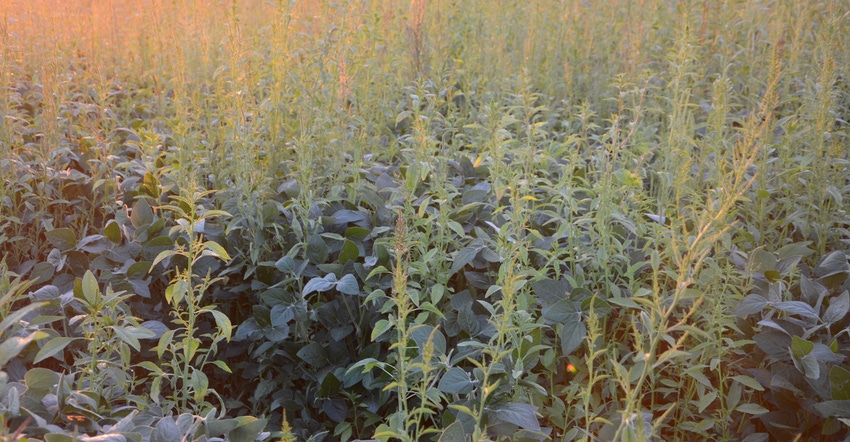
The big news on Oct. 31 was EPA extending the federal registration for dicamba products for spraying over the top of soybeans for another two years. But as some wise yet anonymous person once said, “The devil in in the details.”
Once EPA issued a “stamped label” on Nov. 1, a few details became more obvious. Some interpretations remain to be worked out, and other details on applying dicamba going forward on your farm won’t be clear until state regulators approve the registration.
Here’s what’s clear about the new label so far. Ryan Rubischko, Bayer dicamba portfolio lead, answers questions in this exclusive interview. Bayer markets Xtendimax for Xtend soybeans. The other two dicamba products with labels for application on Xtend soybeans include Engenia from BASF and FeXapan from DowDuPont.
The original EPA announcement extending dicamba registration indicated applications would be limited to 45 days after planting soybeans or 60 days after planting cotton. Can you provide more insight into how that might be interpreted?
For soybeans, the label actually says application must occur within 45 days after planting or prior to the R1 stage of soybean growth, whichever comes first. (R1 is defined in the Purdue University Corn and Soybean Field Guide as beginning bloom stage when an open flower is visible at any node on the main stem.)
For cotton, the label says applications must occur within 60 days after planting or by mid-bloom, whichever comes first.
Would this apply to double-crop soybeans as well, which are usually planted later?
Our interpretation is that the federal label also applies to double-crop soybeans. Our experience is that most growers tend to spray relatively soon after planting in those situations anyway due to weed pressure.
The previous label restricted spraying between sunrise and sunset. The new label reads spraying is allowed one hour after sunrise to two hours before sunset. Is this a major change?
It appears to be just a further extension of awareness about temperature inversions. Some states had already imposed stricter restrictions on spraying times. Farmers are now more aware that when it gets hazy toward evening, it’s often because an inversion is forming. This isn’t just an issue with dicamba herbicides. Many other herbicide labels also state that applications can’t be made during a temperature inversion.
How will you handle the annual training requirement?
This will be a continuation of what we were already doing. Nearly 100,000 growers were trained in 2018, either through company or state-sanctioned programs. Some states may choose to offer their own training again and require growers to attend it. We will offer training and keep records of who is trained for those in states where there isn’t a requirement to attend a specific training course.
The new label requires purchase and application by a certified applicator, not someone working under a certified applicator. Is this a major change?
Several states already required purchase and application by a certified applicator in 2018. If your state still allowed application by someone without certification working under someone with a license, it simply means that person will need to be certified this year. Expect states to issue more details about this requirement and how those who need certification can get it. By making the requirement known this far ahead of the 2019 spraying season, there should be plenty of time to earn certification.
Now that EPA extended registration, what happens next?
Bayer applied for registration for Xtendimax in 34 soybean and/or cotton-growing states. Each state must approve the registration. We expect many states will move quickly for approval so that growers know what to expect. Some states had more stringent restrictions than the federal label in 2018.
Do you feel those state-specific restrictions are necessary?
We don’t believe any additional restrictions beyond the federal label are needed. During the 2018 season, we worked with 13 universities, many in states which felt the need to impose extra restrictions, to demonstrate and confirm that the product can be used safely when label directions are followed. We weren’t required by EPA to conduct these studies.
Based on those results and reports from growers in 2018, we have confidence in the product. Over 60% of the drift incidents reported to us in 2018 were traced back to the wind blowing toward a sensitive crop, either due to a wind shift or because the applicator didn’t take precautions.
The new label issued by EPA maintains the 110- or 220-foot buffer, but also adds additional buffer requirements. Can you explain it?
First, note that no application of Xtendimax can be made when the wind is blowing toward an adjacent, non-dicamba tolerant sensitive crop. The label says that if you’re spraying in a county with an endangered species, you must still leave the 110- or 220-foot buffer on the side of the field next to a sensitive crop, but you must also leave a 57-foot buffer on all other sides of the field. We are expecting clarification from EPA on two points. First, which counties in which states have endangered species? Second, what other crops such as corn can be counted as buffers?
How can growers find out this information?
We encourage them to visit our website, roundupreadyxtend.com. We will post as much information as possible, including links to the Xtendimax label, information about which states have approved registration and which counties across the country are on the endangered species list. We will also post information about training sessions as the information becomes available.
About the Author(s)
You May Also Like




